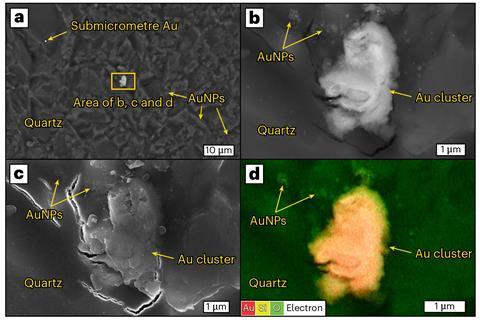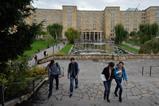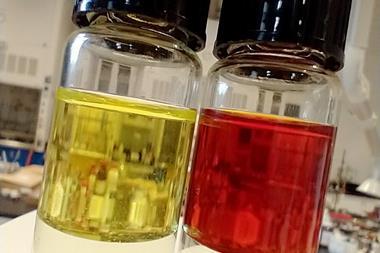The pressure created by earthquakes could trigger quartz veins to generate enough electricity to form large nuggets of gold, researchers in Australia have found.

Most gold nuggets originate in quartz veins when gold-bearing hydrothermal fluids from the earth’s crust are transported along fracture networks by earthquakes. ‘[Quartz veins] form over the accumulation of thousands of earthquake events,’ says Chris Voisey, a geologist at Monash University in Melbourne, Australia and lead researcher on the study. ‘There’s a fault that turns into a quartz vein and then it’ll fracture open repeatedly during many, many earthquakes… And every time it fractures open, a gold-bearing fluid from deep in the crust flows through it.’
The overall mechanism behind the transport and deposition of gold are relatively well understood but the formation of large nuggets of gold in quartz veins has remained something of a mystery, particularly given the low concentration of gold in hydrothermal fluids and the chemical inertness of quartz. ‘In this type of setting gold is transported in fluid as molecules in tiny amounts,’ explains Laura Petrella, a geologist at the University of Western Australia, who was not involved in the study. ‘So we struggle to understand how big nuggets can form, considering that we have only a little amount of gold in the fluid.’
Quartz veins are known to emit a measurable electric charge when put under mechanical stress, such as by an earthquake – a phenomenon known as piezoelectricity. To investigate whether earthquake-induced piezoelectric discharges from quartz could explain the formation of gold nuggets, the researchers conducted experiments using slabs of quartz. The slabs were placed within sealed chambers containing gold-rich solutions and the shaking of an earthquake was replicated mechanically.
‘Using our model, you have a quartz vein, it breaks open during the “earthquake”, gold rich fluid is rushing by, but the ground is shaking because it’s an earthquake, so it’s all rattling, and that rattling will stress the quartz crystals that are in the vein wall and generate a voltage,’ Voisey explains. ‘If that voltage is high enough ie higher than the redox potential of a gold-bearing ligand or gold-bearing molecule, that gold will get reduced, so it gets separated from the molecule – it’ll precipitate as native gold.’
‘Pure scientific endeavour’
As expected, the rattled quartz created an electrical field and this resulted in the gold nanoparticles in the solution being drawn out and deposited as grains along the vein. However, this wasn’t the end of the story.

‘When [the gold] precipitates, it then becomes the focus for ongoing electron donation, because gold is a conductor and quartz is an insulator,’ says Voisey. ‘If you have gold on a piece of quartz and you deform the quartz, it will use that voltage to donate its own electrons, and when it does that, it becomes the focus for further gold reduction from the fluid and it’ll grow and become a big gold nugget.’
Voisey says this work was a ‘pure scientific endeavour’. ‘The cool thing about it is that we’re explaining something that we haven’t been able to explain. We know a lot about how gold mineralises – people have been studying this forever, but this was just one of the little outstanding things.’
Petrella says it was a ‘novel idea’ to look at the electric properties of quartz. ‘It’s very interesting … of course, this type of gold deposit forms as a result of fracturing in the crust so we already kind of know they form as a result of earthquakes … but they actually show that the specific property of the quartz might be able to trigger the deposition of gold that is in the fluid originally.’
She says that one limitation of the work is that for the process to work the quartz would need to be crystalised already, which might not always be the case. ‘This theory works really well for what we call remobilisation. Remobilisation is when you have a vein already formed with gold already in it, and then when you apply more stress on this vein, then you will move around, redissolve the gold, and then reprecipitate it. So in the case of remobilisation, this theory that they propose would work really well.’
She says that that the researchers’ findings could have important applications in gold mining. ‘Mining explorers would be really interested in knowing how you concentrate gold, because it would help in targeting high-grade gold deposits – obviously, it’s more environmental friendly to mine a deposit where gold is concentrated.’
References
CR Voisey et al, Nat. Geosci., 2024, 17, 920 (DOI: 10.1038/s41561-024-01514-1)

















No comments yet